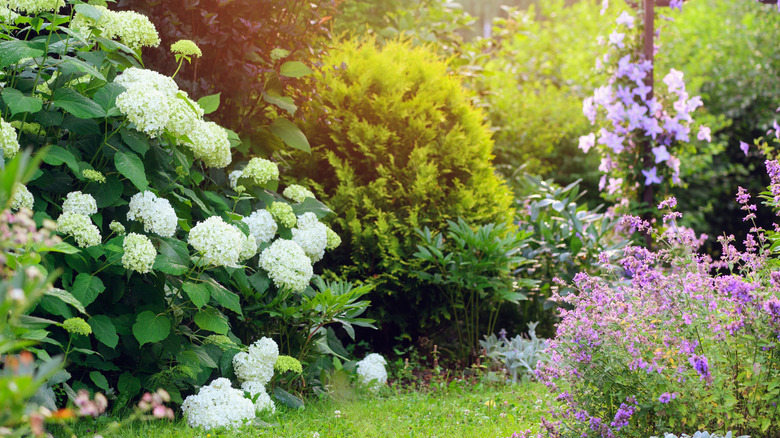Beautiful Companion Plants Martha Stewart Loves Pairing With Hydrangeas
One of the most splendid gardens at Martha Stewart's New York farm is a multicolored hydrangea border near the chicken coops. On The Martha Blog, Stewart documented the addition of three delicious-sounding hydrangea hues: Berry White, Strawberry Sundae, and Vanilla Strawberry. She paired these flowers with sweet-smelling Bubblegum Pink and Coral Crème Drop phlox. It's part of her companion-planting strategy, which involves incorporating irises, ligularias, Aruncus, Euonymus, and other perennials that play well with hydrangeas.
Companion planting can benefit gardens by deterring troublesome insects and suppressing weeds. What's more, some plants enrich the soil nitrogen, which other flora need. With hydrangeas, pay special attention to what nearby plants are adding to the soil or subtracting from it. For example, if companion plants add an overabundance of nitrogen, your hydrangeas may have fewer flowers and weaker roots. If you suspect this is the case, test the pH level and nutrient content of the soil near your hydrangeas. If anything is out of balance, amending the soil with compost is a good first step. Be aware that adjusting the soil's pH level can also change the color of your hydrangeas' flowers.
To set yourself up for a successful hydrangea bloom every year, also familiarize yourself with other challenges that can hinder the plant's growth. For instance, too much phosphorus can impede nutrient absorption, and too much potassium can lead to oddly shaped leaves. A common mistake when planting hydrangeas is choosing the wrong site. Avoid heavy or poorly drained soil and bright, constant sunlight. You'll need to consider these soil and sun needs as you select companion plants for your hydrangeas.
How to select companions for hydrangeas
When seeking partners for your hydrangeas, opt for plants with a similar affinity for damp soil and efficient water drainage. This way, it's easy to provide consistent moisture to the whole garden. Choosing plants with similar light and temperature preferences also helps each specimen stay healthy. The companions in Martha Stewart's hydrangea border all appreciate the area's early-day sunshine and late-day shade.
The buddies Stewart selected for her hydrangeas also encourage biodiversity and pollination. In many parts of the United States, hummingbirds and butterflies flock to phlox for its autumn nectar supply. Aruncus plants attract a range of songbirds while tolerating the nibbles of deer and rabbits. Meanwhile, native irises help sustain a region's pollinators while fending off pests.
Looking for other plants that interest pollinators and share hydrangeas' light, soil, and moisture requirements? Try common foxglove (Digitalis purpurea), which is a butterfly magnet; purple coneflower (Echninacea purpurea), which is beloved by bees; and amethyst flower (Browallia speciosa), which is a favorite of hummingbirds. Searching clever ways to add red to your hydrangea garden so it attracts more hummingbirds? Ruby-colored begonias may be the answer. Hummingbirds appreciate not only their bright hue but their tube-shaped flowers, which are the perfect shape for their slim beaks.
Pairings that enhance a hydrangea garden's beauty
Consider flowering schedules when mapping out companion plantings. Irises and hydrangeas are an ideal pairing because they bloom at different points in the growing season. This keeps your garden looking vibrant throughout the spring and summer. Summer-blooming hydrangeas can even help you care for your irises and other spring-blooming plants after the flowers die. Instead of cutting back the iris leaves, which are busy making nutrients for next year's flowers, conceal them with your hydrangea bushes' jumbo blossoms.
Though it's essential to choose companions that share hydrangeas' sun and water demands, they needn't look like hydrangeas. In fact, it's often better if they don't. Plants with different heights, leaf shapes, and petal styles can add visual interest to your garden. Ligularias' spiky petals and rounded leaves provide a nice contrast to the shapes of hydrangea bushes. The plume-like flowers that decorate goat's beard plants (Aruncus dioicus) offer a new texture to the garden, as well as a graceful movement when a breeze tickles them. Euonymus shrubs can be pruned into pleasing shapes that complement the look of your hydrangeas.
You might even find a beautiful ground cover for under your hydrangea plants. In her blog post, Martha Stewart mentions surrounding her hydrangeas with catnip, but catmint — another plant from the Nepeta genus — is a better ground cover for most gardeners. Catmint produces purple, pink, or white flowers and a minty scent that repels certain pests. Plus, it doesn't spread as readily as catnip, which some states have deemed invasive. Other ground covers that pair well with hydrangeas include coral bells (Heuchera spp.) and speedwell (Veronica spp.).


